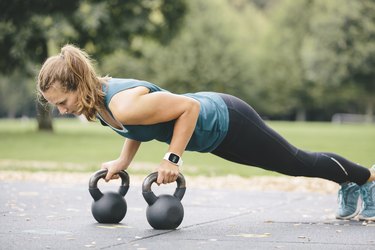
Aside from their shape and center of balance, kettlebells aren't significantly different to dumbbells. If you need more variety in your life, you can do a kettlebell chest workout that's very similar to a chest workout with dumbbells. The main difference is how you hold and control the weights.
Performing Kettlebell Chest Exercises
Video of the Day
Move 1: Basic Kettlebell Press
Video of the Day
It doesn't get any simpler than this move that works the same muscles in the chest as a dumbbell press. The only difference is that the shoulder range of motion is smaller because the upper arms do not drop below chest height. However, you can also do this move on a bench if you prefer.
- Grab two kettlebells and lie back on the floor. Keep your knees bent and your feet flat on the floor.
- Straighten your arms and hold the kettlebells above your chest.
- Contract your core muscles for stability and keep them contracted throughout the exercise.
- Slowly bend your elbows and lower the weights just as you would with a dumbbell press, but keep your elbows a little closer in toward your body.
- Press the kettlebells back to the starting position.
Tip
There are a few different ways to hold a kettlebell. For chest exercises, take an underhanded grip with the handle between your index finger and thumb. Your wrist should stay straight and the orb of the kettlebell will rest on your outer forearm.
Move 2: Kettlebell Bridge Press
This increases the shoulder range of motion of the basic press. It also activates the glutes and works the core muscles.
- Grab your kettlebells and lie on your back with bent knees.
- Press your feet into the floor and lift your hips toward the ceiling. Contract your glutes and maintain a neutral spine.
- Press the kettlebells overhead; then slowly lower them down as you did in the basic press.
- Repeat the press without lowering your hips to the ground.
Move 3: Kettlebell Push-Ups
The push-up is nothing new, but performing it with kettlebells adds a whole new dimension because it requires balance. This increases the challenge for the chest muscles as well as for all the small stabilizer muscles in your arms, shoulders and chest. It's also a killer core exercise.
- From all fours, grasp the kettlebells and align them under your shoulders.
- Come up to a push-up position, contract your core muscles and make sure your wrists are vertical.
- Lower down with control, bringing your chest down as far as the range of motion of your shoulders will allow.
- Keep your wrists locked and press back up.
Tip
Incorporate supersets into your kettlebell chest routine to really fatigue the muscles. According to the National Academy of Sports Medicine, a superset involves doing a more traditional exercise in a stable environment, like a bench press, followed by a similar exercise in an unstable environment, such as a push-up on an exercise ball. You can do the same thing by doing a set of kettlebell presses immediately followed by a set of kettlebell push-ups.
Read more: How to Get Started Training With Kettlebells
Trying Kettlebell Flys
Performing kettlebell flys is no different than performing them with dumbbells. Just make sure to test out your weight first as the difference in center of balance might cause you to need a lighter or heavier weight than you would use with dumbbell flys.
- Grab your kettlebells and lie back on a bench or position them next to the bench where you can reach them.
- Position your feet flat on the floor. Alternatively, the American Council on Exercise suggests placing them on a raised platform, which will enable you to maintain a flat spine.
- Extend your arms above your chest, with your wrists in a straight and locked position.
- Slowly open your arms out to the side, keeping a slight bend in your elbows. Keep the insides of your wrists facing each other. Do not allow your wrists to hyperextend; keep them straight or slightly flexed.
- Lower down until the weights are at chest height. Then slowly bring your arms back to the starting point in a wide arc.
Tip
Did you know? Kettlebells were first used in the 1700s by Russian strongmen to improve strength, endurance, balance and flexibility, reports the American Council on Exercise.